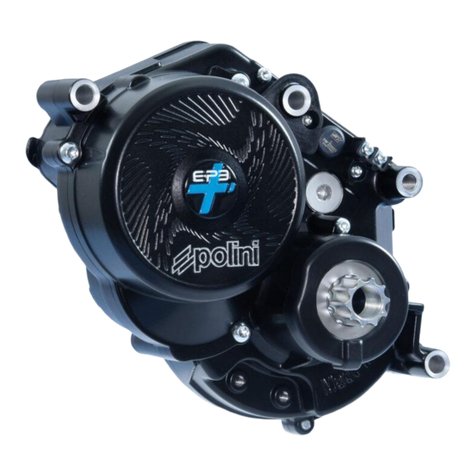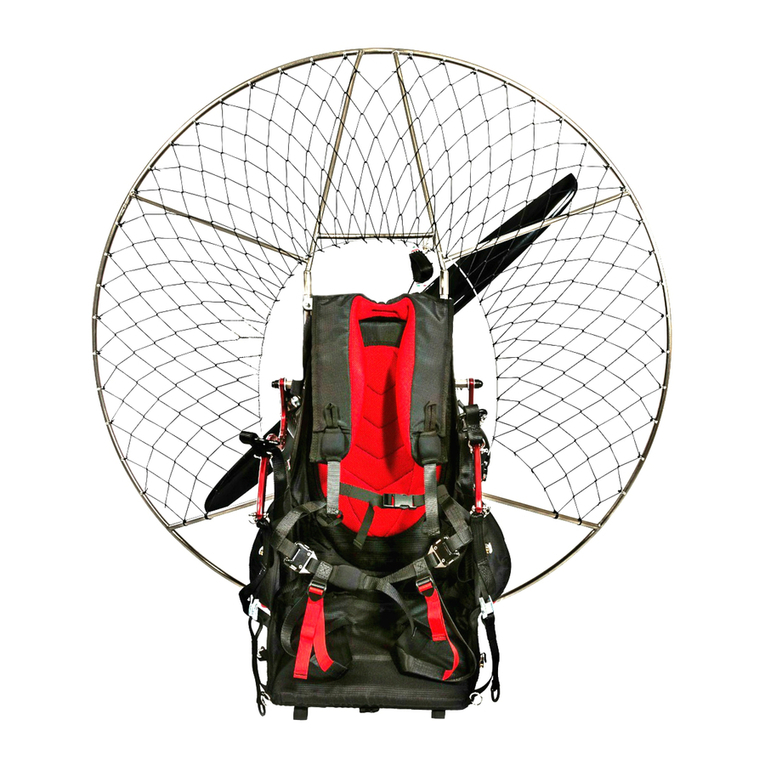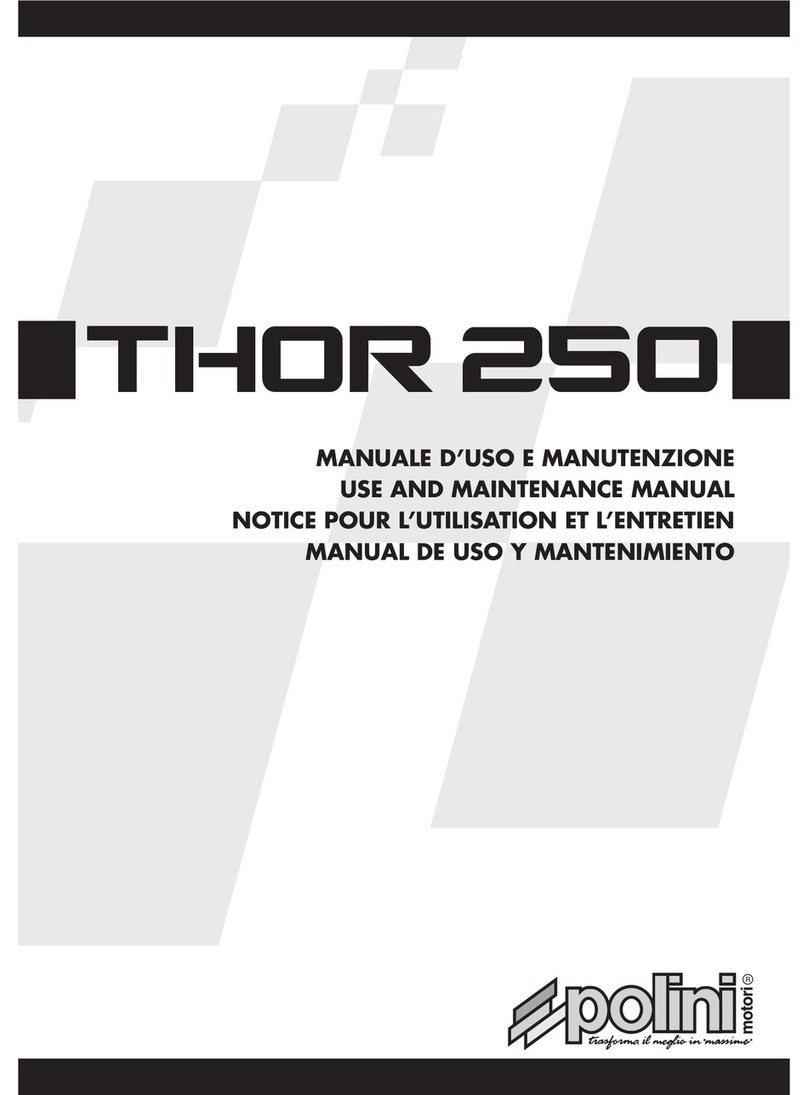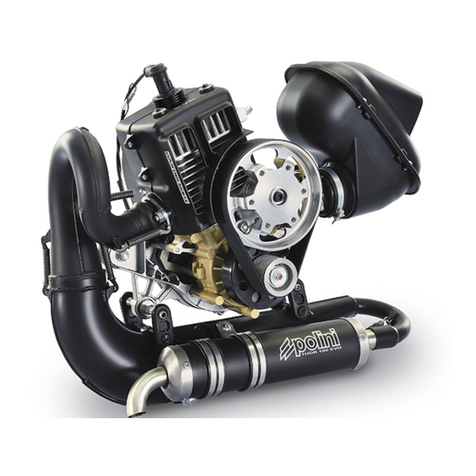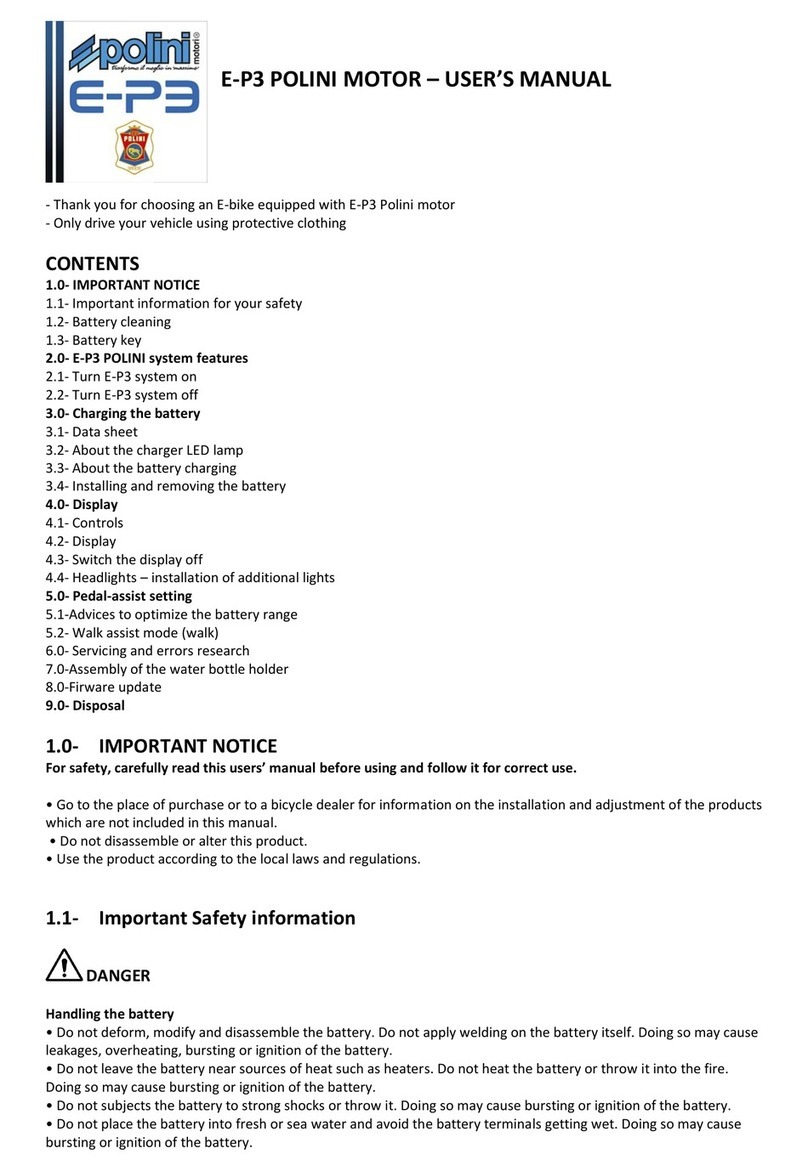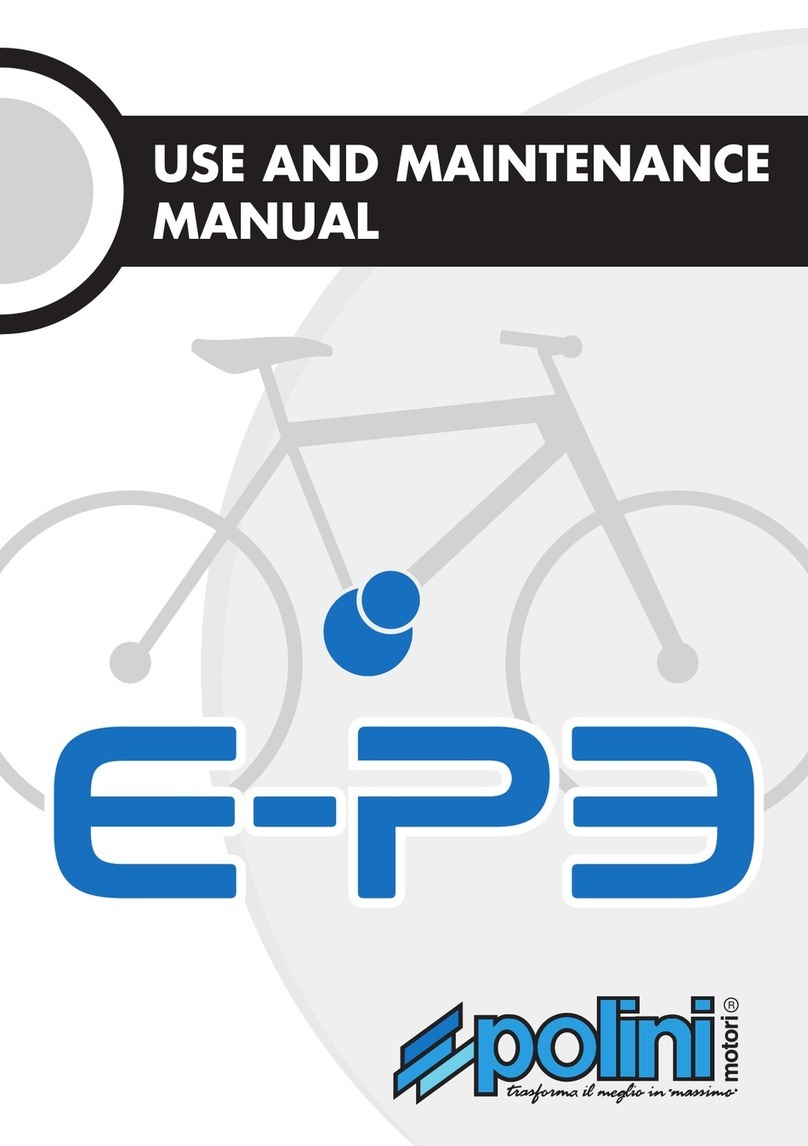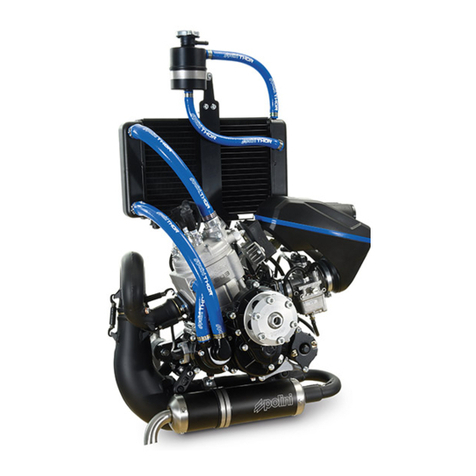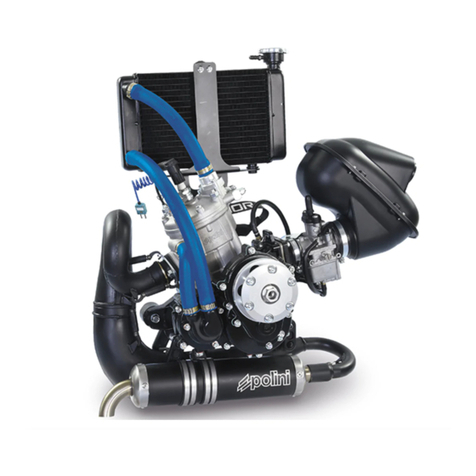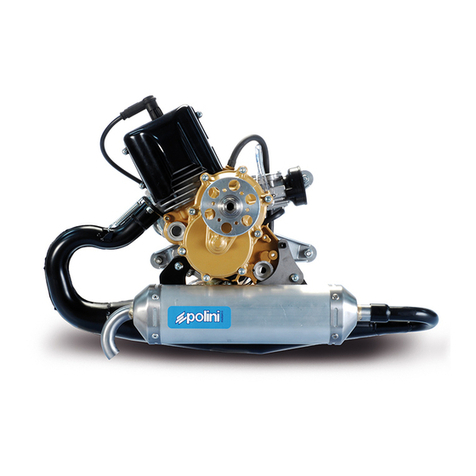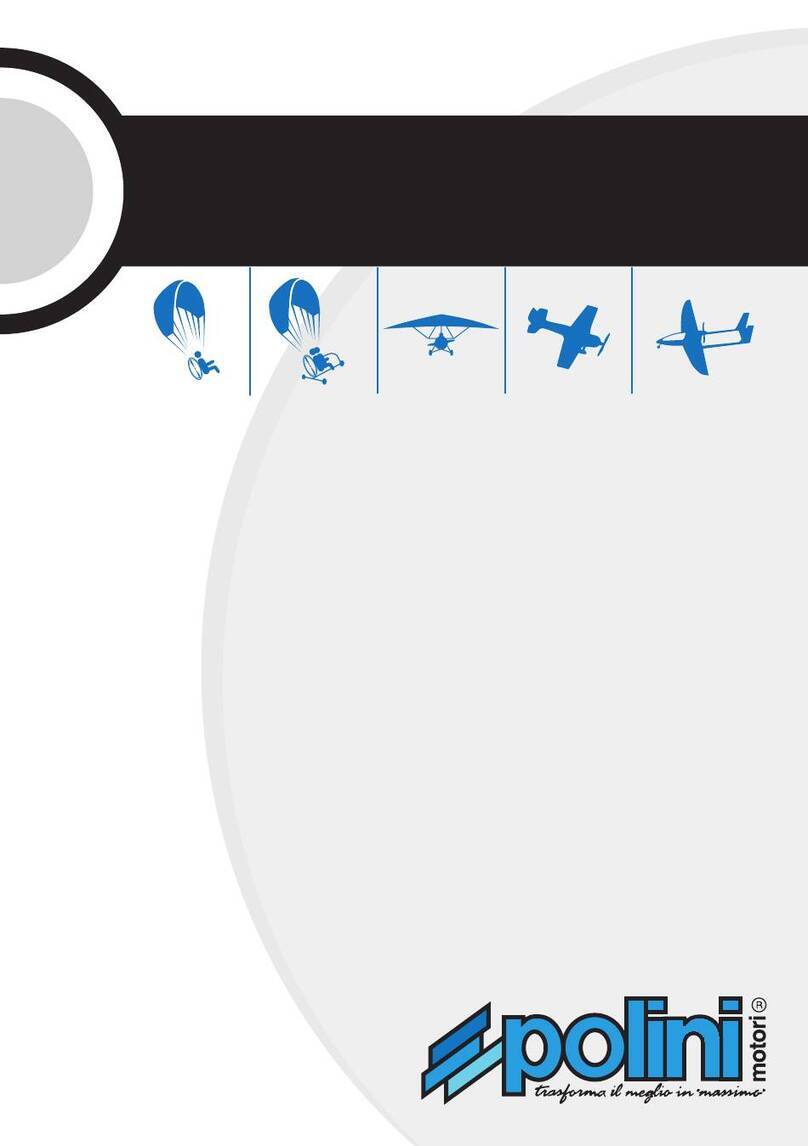- Limitazioni di responsabilità
Conformemente a quanto stipulato nella presente garanzia, gli
obblighi della Polini saranno limitati alla riparazione del componente
difettoso o, a discrezione, alla sostituzione di uno o più componenti,
secondo quanto sarà ritenuto necessario per porre rimedio ad ogni
malfunzionamento dovuto ai difetti di materiale o di manodopera
coperti dalla garanzia. Alcuna responsabilità può essere imputata alla
Polini o al distributore del motore per ogni problema o danno recato a
persone/cose/animali riscontrato durante tutta la vita del motore.
Ricordiamo che questo prodotto non è certificato ed è dedicato a
velivoli sperimentali e che in qualsiasi momento può rompersi o
smettere di funzionare. Pertanto non sono coperti né da garanzia né
da risarcimento i danni causati:
- a persone/animali/cose causati dall’utilizzo generico del motore.
- a persone/animali/cose causati da una collisione con l’elica o una
qualsiasi parte staccatasi dal motore.
- al telaio, componenti del velivolo e/o all’elica causati dalla
collisione con una qualsiasi parte proveniente dal motore.
- spese di recupero, di spedizione, telefoniche o di noleggio di
qualsiasi tipo, inconvenienti o perdite di tempo, o altri danni indiretti.
PERICOLO! Questo motore, non certificato, può spegnersi di
colpo. L’interruzione del motore può provocare atterraggi di fortuna
che possono produrre ferite o portare alla morte. Il velivolo spinto da
questo motore dovrebbe volare soltanto negli spazi aperti e negli
orari di luce. L’acquirente si assume tutto il rischio per l’uso ed è
consapevole che durante il suo utilizzo questo motore si potrebbe
spegnere di colpo. Questo prodotto non è coperto da responsabilità
civile prodotti. Chi vola con questo motore o semplicemente lo
accende si assume tutti i rischi inerenti lo sport del volo a motore ed
ogni responsabilità per danni a cose e a persone, o decesso causato
dall’uso di questo prodotto. In considerazione di ciò, non sono coperti
da garanzia i danni causati dall’installazione del motore su apparecchi
che richiedono motori certificati. /su apparecchi ai quali non è
idoneo/ su apparecchi che richiedono diverso tipo di motore.
L’odierno venditore pertanto non risponderà di danni causati
all’utilizzatore od a terzi.
2- CARBURANTE
Il Thor è un motore a 2 tempi che necessita di una miscela di benzina
e olio. Utilizzare solo benzina verde acquistata al distributore con un
numero di ottani pari a 98 di buona qualità . Addizionare la benzina
con olio sintetico di buona qualità al 2%. E’ possibile utilizzare una
miscela con olio al 1,5% utilizzando i seguenti oli:
MOTUL 800 – VALVOLINE RACING 2T FULL SYNTHETIC SAE 50 - BAR-
DAL KXT - ELF 976 – ELF 909.
Non conservare a lungo la benzina in contenitori perché subisce un
deterioramento della qualità, utilizzare contenitori metallici certificati
per il trasporto carburanti. Miscelare la benzina con l’olio solo al
momento dell’utilizzo.
AVVERTENZA: il tipo di incrostazioni carboniose depositate sulla
testa, sulla candela e sullo scarico del cilindro sono informazioni che
indicano il tipo di miscelazione del vostro motore. Si rammenta che
una combustione troppo ricca d’olio non allunga la durata del motore.
ATTENZIONE: la benzina è estremamente infiammabile ed
esplosiva. Eseguire queste operazioni in un luogo ben ventilato e a
motore spento. Non fumare, non provocare scintille o fiamme
nell’area in cui la benzina viene conservata e dove avviene il
rifornimento.
ATTENZIONE! Solo per i clienti Americani. Il numero di ottani
Europeo non equivale a quello Americano:
es. EU 95 OTTANI = US 91 OTTANI / EU 98 OTTANI = US 93 OCTANE
Per i motori Thor usare una benzina con un alto numero di ottani
(non meno di US 91).
3- MESSA IN MOTO
Avviare il motore solo dopo essersi accertati che sia tutto in ordine e
perfettamente funzionante, che non ci siano persone, cose o animali
nei dintorni. Verificare inoltre il corretto serraggio della bulloneria e
controllare l’impianto di alimentazione.
3.1- CARBURATORE WALBRO WG8
Primo avviamento a freddo: riempire il circuito di alimentazione
carburante utilizzando l’apposita pompetta (attenersi alle indicazioni
del costruttore del telaio per l’individuazione ed il corretto utilizzo di
quest’ultima).Per facilitare l’operazione premere delicatamente con
un dito la membrana del carburatore attraverso l’apposito bottone
indicato dalla freccia in foto 1. Il riempimento va eseguito fino a
quando si vede arrivare la benzina al carburatore. Quando ciò
avviene fermarsi immediatamente; se si continua ad agire sulla
pompetta il carburante tende a filtrare all’interno provocando
l’ingolfamento del motore.
Posizionare la levetta dello starter in posizione chiusa (foto 1): a
questo punto impugnare l’avviatore ed iniziare a tendere la fune fino
a quando si indurisce. Tirare dunque con forza e decisione senza
accelerare fino a quando il motore prova ad accendersi (non ripetere
questa operazione più di 3 volte altrimenti il motore potrebbe
ingolfarsi), a questo punto è necessario riposizionare la levetta dello
starter in posizione aperta (foto 2) ed agire nuovamente sulla corda
di avviamento senza accelerare. Se il motore non dovesse avviarsi con
i primi due colpi riprovare accelerando leggermente.
3.2- CARBURATORE CP
Il motore con carburatore CP è dotato di pompa integrata sul motore
(foto 3-A ), utilizzare la pompa per far arrivare il carburante al
carburatore, se il carburatore è vuoto una volta raggiunto lo stesso
pompare per tre volte per riempire la vaschetta. Se la vaschetta è già
piena di carburante non è necessario pompare ulteriormente
carburante, la benzina nella vaschetta è sufficiente per l’avviamento
Per avviare il motore tirare verso l’alto la leva nera starter
posizionata nella parte superiore del corpo carburatore. Azionare
l’avviatore senza accelerare fino a che il motore non parte. Una volta
acceso spegnere il motore,disinserire lo starter abbassandolo e
riavviare il motore questa volta se necessario accelerando lievemente.
Per la vostra sicurezza avviate il vostro motore solo dopo esservi
COMPLETAMENTE imbragati!
ATTENZIONE: Durante tutte le fasi tenere sempre in mano
